D o m i ni o n
A U G U S T 5 - O C T O B E R 1 2 0 1 7
The struggle to control nature is deeply rooted in Western thought. The ideal garden has been used throughout art history to convey our quest for dominion and nature’s compliance. Through the ages we have enlisted technologies to mediate, document and tame nature...or to understand it. This exhibition brings together video, electronic media, appropriated material, sound and light from four internationally acclaimed artists. Each work captures migratory, programmed movements, flows & computations between the natural and the technological realms. We move from hauntingly familiar moments of animated, naturalistic movement or behavior to the sudden realization of some underlying mechanical or technological control. Each work shifts us between the illusory and the real; the organic and the code; nature and technology.
The Centrifugal Soul is a fantastical combination of magical illusion and scientific theory. From early Victorian times we have the zoetrope: a pre-film, animation device. This one is big and spins in rapid rotation and stroboscopic light to create a lush, dizzying illusion of flapping, mating, preening birds and flowers. Mat Collishaw has immersed himself in the visual supremacy theories of environmental psychologist Geoffrey Miller. Here, all visual excess is spun to the outer surface, captivating us, distracting us from the empty centre.
Jim Campbell is similarly interested in the void and absence. His work explores what might happen when you remove all the details: how much or how little information is required for comprehension? From most perspectives this LED matrix appears as a random array of blinking lights. But from a privileged vantage point, things shift into focus: moving shapes that are barely decipherable to the eye become strangely comprehensible to the mind: the ghostly migration of birds in flight.
A piano soundboard hangs in the gallery. Stripped of it’s weighty, body-housing... suspended, it becomes a more ethereal type of stringed instrument. A flock of migrating swallows alights on the strings; an enchanting act that triggers a series of random notes. But these projected shadows are a flock long gone. Small solenoid devices allow the strings to be plucked by an absence of shadows. Piano Migrations, by Kathy Hinde integrates reality and illusion.
Natures by Davide Quayola are a series of plant studies, described as vibrant, immaterial and contingent. The behavior of plants and flowers is interpolated through precise measurements and generative sound into a new synthetic order. The works in this series are based on the ‘clinamen’, an ancient idea that describes an unpredictable swerve or flow of atoms that was once understood as the origins of life.
The Centrifugal Soul is a fantastical combination of magical illusion and scientific theory. From early Victorian times we have the zoetrope: a pre-film, animation device. This one is big and spins in rapid rotation and stroboscopic light to create a lush, dizzying illusion of flapping, mating, preening birds and flowers. Mat Collishaw has immersed himself in the visual supremacy theories of environmental psychologist Geoffrey Miller. Here, all visual excess is spun to the outer surface, captivating us, distracting us from the empty centre.
Jim Campbell is similarly interested in the void and absence. His work explores what might happen when you remove all the details: how much or how little information is required for comprehension? From most perspectives this LED matrix appears as a random array of blinking lights. But from a privileged vantage point, things shift into focus: moving shapes that are barely decipherable to the eye become strangely comprehensible to the mind: the ghostly migration of birds in flight.
A piano soundboard hangs in the gallery. Stripped of it’s weighty, body-housing... suspended, it becomes a more ethereal type of stringed instrument. A flock of migrating swallows alights on the strings; an enchanting act that triggers a series of random notes. But these projected shadows are a flock long gone. Small solenoid devices allow the strings to be plucked by an absence of shadows. Piano Migrations, by Kathy Hinde integrates reality and illusion.
Natures by Davide Quayola are a series of plant studies, described as vibrant, immaterial and contingent. The behavior of plants and flowers is interpolated through precise measurements and generative sound into a new synthetic order. The works in this series are based on the ‘clinamen’, an ancient idea that describes an unpredictable swerve or flow of atoms that was once understood as the origins of life.
Curation + Design: Sarah Joyce + Gordon Duggan
Jim Campbell (US)
Exploded View (Birds)
Part of the Exploded View Series: These works expand a flat, two-dimensional moving image into a three-dimensional space comprised of 1100 hanging LED’s. When viewed from the front, the flickering LEDs are recognized as birds taking off and landing, commuters bustling through Grand Central Station, a lone figure endlessly running and falling. Move closer or off axis and the flickering becomes abstract, seemingly random.
What happens when you remove all detail: how much or how little information is required for visual comprehension? Jim Campbell’s glittering LED matrix appears as a starry block of blinking, white lights. But from a privileged vantage point, things suddenly shift : moving shapes that are barely decipherable to the eye become strangely comprehensible to the mind and we become aware of an exploding migration of birds in flight.
What happens when you remove all detail: how much or how little information is required for visual comprehension? Jim Campbell’s glittering LED matrix appears as a starry block of blinking, white lights. But from a privileged vantage point, things suddenly shift : moving shapes that are barely decipherable to the eye become strangely comprehensible to the mind and we become aware of an exploding migration of birds in flight.
Image
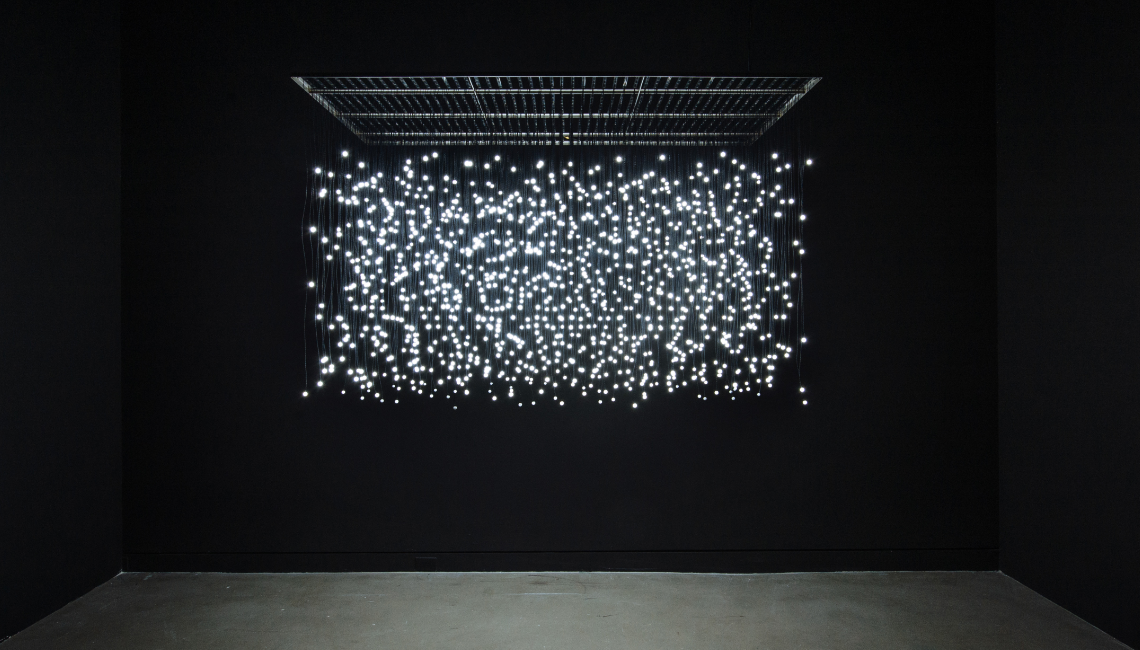
Biography
An electronic-media artist whose work combines film, light emitting diodes (LEDs) and sculptural elements, Campbell pushes the limits of perception and explores the line between representation and abstraction. Rather than working with highly defined images, Campbell, who has degrees from MIT in both mathematics and electrical engineering, eschews clarity in favor of interpretive possibility. He leaves it to viewers to fill in the gaps left in his work, allowing them to personalize it to an unusual degree.
Jim Campbell was born in Chicago in 1956 and now lives in San Francisco. He received two Bachelor of Science Degrees in Mathematics and Engineering from MIT in 1981 and then went on to study Film and Electronic Media Art. He is known for his low res LED works. His work has been shown internationally and throughout North America in institutions such as the Metropolitan Museum of Art, The Museum of Modern Art, NY, Smithsonian, Washington, The Whitney Museum of American Art, San Francisco Museum of Modern Art, The Carpenter Centre, Harvard, The International Center for Photography, New York and the Intercommunication Center in Tokyo. He has won numerous awards & commissions such as a Guggenheim Fellowship, Langlois Foundation, Rockerfeller Foundation Fellowship. His work is included in many major art museum collections. He has lectured on interactive media art at numerous institutions. As an engineer he holds more than a dozen patents in the field of video image processing
Jim Campbell was born in Chicago in 1956 and now lives in San Francisco. He received two Bachelor of Science Degrees in Mathematics and Engineering from MIT in 1981 and then went on to study Film and Electronic Media Art. He is known for his low res LED works. His work has been shown internationally and throughout North America in institutions such as the Metropolitan Museum of Art, The Museum of Modern Art, NY, Smithsonian, Washington, The Whitney Museum of American Art, San Francisco Museum of Modern Art, The Carpenter Centre, Harvard, The International Center for Photography, New York and the Intercommunication Center in Tokyo. He has won numerous awards & commissions such as a Guggenheim Fellowship, Langlois Foundation, Rockerfeller Foundation Fellowship. His work is included in many major art museum collections. He has lectured on interactive media art at numerous institutions. As an engineer he holds more than a dozen patents in the field of video image processing
Credits
Exploded View Birds (2010)
72" x 46"x 38”
Grid of 1152 White LED Lights. Custom Electronics
Courtesy of Jim Campbell and White Light Studio Inc.
72" x 46"x 38”
Grid of 1152 White LED Lights. Custom Electronics
Courtesy of Jim Campbell and White Light Studio Inc.
Mat Collishaw (UK)
The Centrifugal Soul
The Centrifugal Soul is a fantastical combination of magical illusion and scientific theory. From early Victorian times we have the zoetrope: a pre-film, animation device. This one is big and spins in rapid rotation and stroboscopic light to create a lush, dizzying illusion of flapping, mating, preening birds and flowers. Mat Collishaw has immersed himself in the visual supremacy theories of environmental psychologist Geoffrey Miller. Here, all visual excess is spun to the outer surface, captivating us, distracting us from the empty centre.
Image
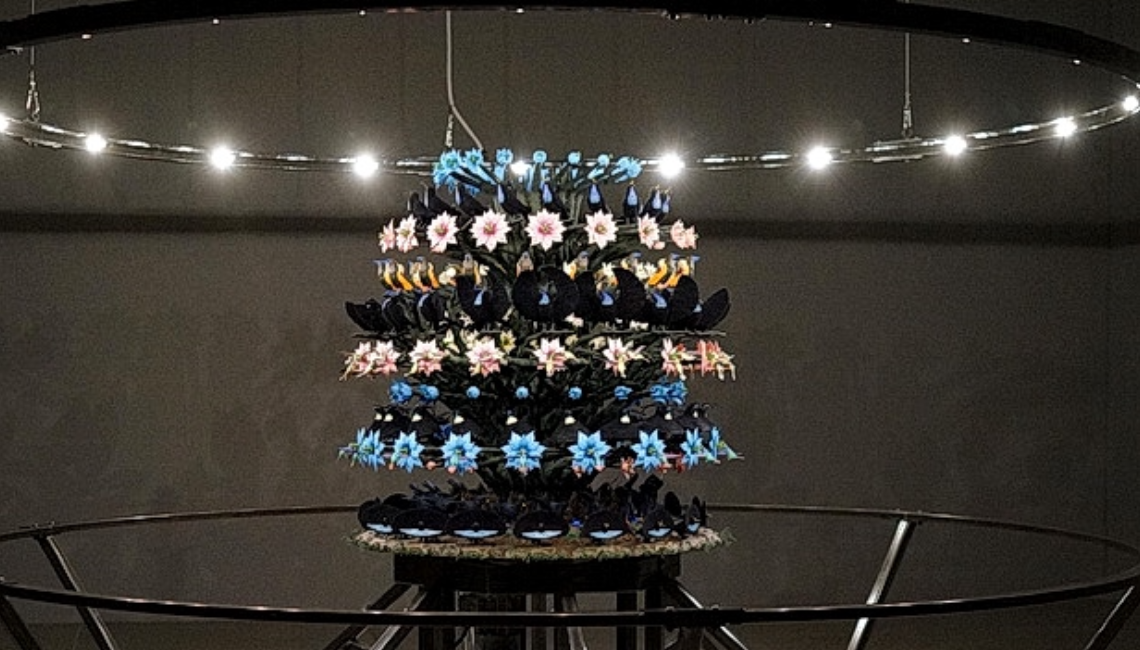
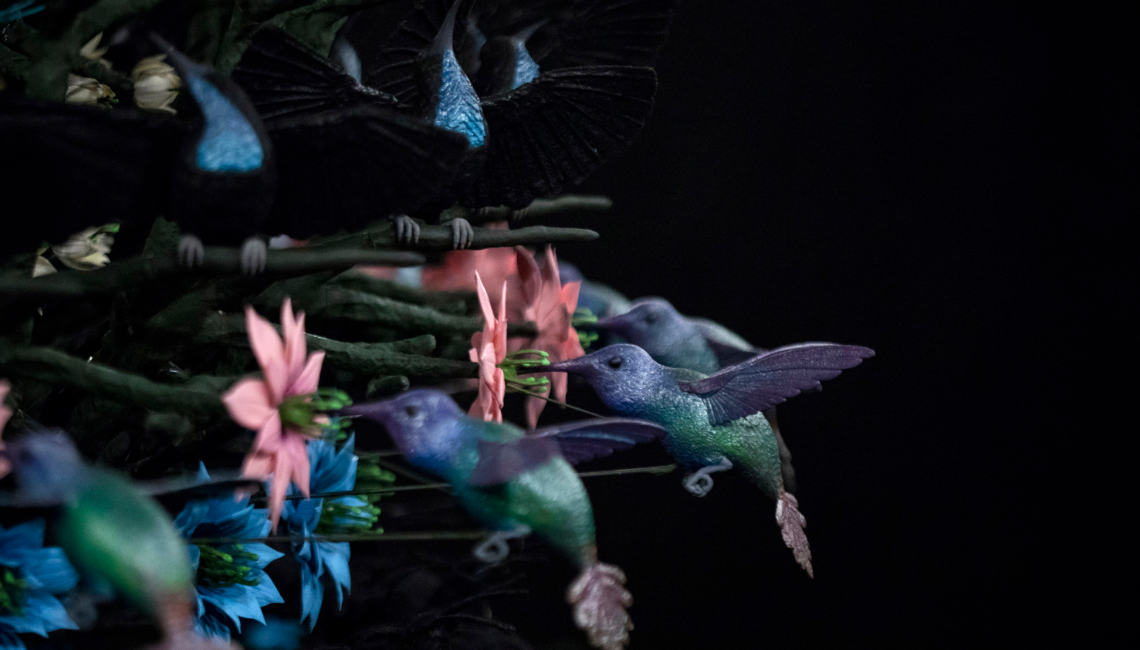
Biography
Mat Collishaw (b. 1966) is a key figure in the important generation of British artists who emerged from Goldsmiths’ College in the late 1980s. He participated in Freeze (1988) and since his first solo exhibition in 1990 has exhibited widely internationally.
Biography Courtesy of Blain/Southern, London
Mat Collishaw (b. 1966), received his BFA from Goldsmiths College, London, in 1989 and began his career exhibiting the acclaimed work Bullet Hole alongside his Goldsmiths contemporaries at the legendary show Freeze in 1988, and at Modern Medicine in 1990. Both shows were curated by Collishaw’s long-term friend Damien Hirst and are renowned for the rise to prominence of the YBAs (Young British Artists).
Collishaw’s work envelops us in a twilight world poised between the alluring and the revolting, the familiar and the shocking, the poetic and the morbid. With a visual language embracing diverse media, the beauty of Collishaw’s work is compelling – seductive, captivating, hypnotic – yet repelling as we perceive the darker fantasies within. A repulsion triggered not by what we see, but by our innate response to it. Something between beautiful and abject.
Pornography, the crucifixion, gleaming fairies, syphilitic child prostitutes, bestiality, bondage, addiction, religion, exaltation and despair, even the final hours of a death-row inmate. There is seemingly no taboo left unbroken, no dark corner Collishaw is unwilling to explore – and yet, the work is utterly romantic, exquisitely beautiful, an expression of Collishaw’s wish to “create images that are awe-inspiring”. The forbidden has always fascinated Collishaw: “I am fuelled by things in my past which were suppressed or held at a distance, which have generated some form of hunger to make my work.” Hardly surprising then, that themes such as stifled sexual desire, brutal and perverse lust, the power of media imagery and the concept of divinity recur throughout his oeuvre.
What is surprising, startling even, is the tenderness and ecstasy – the almost sublime – embodied within the work. “There are mechanisms within us that are primed to respond to all kinds of visual material, leaving us with no real say over what we happen to find stimulating.” Collishaw is interested in imagery’s effect on the subliminal, and explores this by making the vile desirable, the repulsive inviting, whilst discretely positioning himself within art-history through his reference to old masters and contemporary dialogues, as in his work The End of Innocence (a digital recreation of Francis Bacon’s painting of Velasquez’s Pope Innocent X) or his questioning of Victorian mores and ideals, executed with 21st century technology.
Collishaw’s interest in the Victorians is no coincidence: 19th century Britain viewed itself in the light of scientific progress and empirical soberness. An age inhabited by educated and prosaic people. In retrospect however, child prostitution, poverty, perversion and a collective blood-lust ran parallel to what was deemed an enlightened age. Collishaw references the Victorian period by simulating its elaborately decorative, romantic style, but he indirectly conjures up that society’s dark side, the corrupt underbelly so pertinent to the present day. He drags our darkest urges into the light – illustrating that humans will never overcome their baser instincts, regardless of aesthetic or scientific advancement. The fact that Collishaw does not take the moral high ground makes his work all the more compelling: he simply shows us the beautiful – even if it is a beauty that sometimes turns out to be highly suspect.
The Victoria & Albert Museum commissioned Collishaw with a monumental onsite project, Magic Lantern, which – installed in the cupola above the entrance – appropriated the very architecture of the V&A creating a beacon of light, complete with an attendant swarm of moths, and was visible across London during the winter months of 2010 - 2011.
Mat Collishaw’s work has been exhibited in numerous solo shows around the world, including: New Art Gallery in Walsall (2015), his first major survey exhibition in the UK since 2005, concurrent with his exhibition in Walsall, Collishaw exhibited a new work at the Library of Birmingham, In Camera, inspired by the Library’s photography collection. Black Mirror, Galleria Borghese, Rome (2014), Mat Collishaw: The Yielding Glass,An Gailearaí, Ghaoth Dobhair, Londonderry (2014); Mat Collishaw: Afterimage, Arter, Istanbul (2013); Mat Collishaw: Preternatural, FaMa Gallery, Verona (2013); La vie de château, Les Châteaux de la Drôme, Ladrome (2013); Mat Collishaw, Pino Pascali Museum Foundation, Bari (2013); Mat Collishaw, Bass Museum of Art, Florida (2013); THIS IS NOT AN EXIT, Blain|Southern, London (2013); Crystal Gaze, Raucci/Santamaria Gallery, Naples (2012); Vitacide, Tanya Bonakdar Gallery, New York (2012); Creation Condemned at Blain|Southern London (2010); Retrospectre, BFI Southbank, London (2010); Hysteria, Freud Museum, London (2009); Shooting Stars, Haunch of Venison, London (2008); Museum of Contemporary Art, Warsaw (2000); Galeria d’Arte Moderna, Bologna, Italy (1999); Life/Live, Musée d'Art Moderne de la Ville, Paris and The Brooklyn Museum, New York (1998); Duty Free Spirits, Lisson Gallery, London, (1997) and Camden Arts Centre, London (1996). Mat Collishaw currently has a solo exhibition titled Fountains Relief at Fountains Abbey & Studley Royal in North Yorkshire as part of their folly! exhibition series.
Recent group exhibitions include: A Weed in a Plant out of Place,Lismore Castle Arts, Ireland (2016); SerpentiForm, Museo di Roma, Rome (2016); Na wspak (ciała i ogrody, 9thBiennale of Photography, Arsenal Municipal Gallery, Poznań(2015); SUBSTANCE, Timothy Taylor, London (2015); L’inconscient pictòric(the pictorial unconscious), MNAC, Barcelona (2015); In Search of the Miraculous, Newlyn Art Gallery (2015); SNAP Art at the Aldeburgh Festival, Aldeburgh Music, Aldeburgh (2015); Nature Morte, Contemporary artists reinvigorate the Still-Life tradition, Hå gamle prestegard (2015); Gallery of Wonder, Northumberland; Woodhorn; Powburn; Spittal; Falstone; Alwinton; Newcastle (2015); Glasstress 2015 Gotika, Istituto Veneto di Scienze Lettere ed Arti, Palazzo Franchetti, Venice, (2015); NGORONGORO – Artist Weekend, Studiobuildings, Lehderstrasse, Berlin-Weissensee, (2015); “The time … and there was time”, from Helga de Alvear ‘ Collection, Fundación Helga de Alvear, Cáceres, (2015); How to Construct a Time Machine, MK Gallery, Milton Keynes,(2015); The Omnivore’s Dilemma: Visualized, University of Connecticut Contemporary Art Galleries, Mansfield, (2015); SMAC Art Gallery, curated by Keith Coventry and Helen A Pritchard, Cape Town (2014); Stations of the Cross, St Marylebone Church, London, (2014); Vanitas: Fashion and Art, Bass Museum of Art, Florida (2014); Corporeality and Sexuality, Votive Church, Vienna (2014); The Bigger Picture: Works from the 1990s, Tanya Bonakdar Gallery, New York (2014); Out Of Our Heads, Shoreditch Town Hall, London, (2014); Diacore presents Ron Arad’s Last Train, Ron Arad Studio, London, (2014);Today’s Specials Brought to you by Pace London & Abdullah Al Turki, Pace Gallery, London, (2014); Deloitte Ignite 2014 -Myth – The Feather and the Flame, Royal Opera House, London, (2014).
Blain|Southern, Other Criteria and Thames & Hudson have published books with Collishaw’s work and he won XVI edition of the Pino Pascali Prize in July 2013.
The artist lives and works in London. He is represented by Blain Southern in London + Berlin, Tanya Bonakdar Gallery in New York, Raucci/Santamaria Gallery in Naples, and Galerie Analix Forever in Geneva.
Mat Collishaw (b. 1966), received his BFA from Goldsmiths College, London, in 1989 and began his career exhibiting the acclaimed work Bullet Hole alongside his Goldsmiths contemporaries at the legendary show Freeze in 1988, and at Modern Medicine in 1990. Both shows were curated by Collishaw’s long-term friend Damien Hirst and are renowned for the rise to prominence of the YBAs (Young British Artists).
Collishaw’s work envelops us in a twilight world poised between the alluring and the revolting, the familiar and the shocking, the poetic and the morbid. With a visual language embracing diverse media, the beauty of Collishaw’s work is compelling – seductive, captivating, hypnotic – yet repelling as we perceive the darker fantasies within. A repulsion triggered not by what we see, but by our innate response to it. Something between beautiful and abject.
Pornography, the crucifixion, gleaming fairies, syphilitic child prostitutes, bestiality, bondage, addiction, religion, exaltation and despair, even the final hours of a death-row inmate. There is seemingly no taboo left unbroken, no dark corner Collishaw is unwilling to explore – and yet, the work is utterly romantic, exquisitely beautiful, an expression of Collishaw’s wish to “create images that are awe-inspiring”. The forbidden has always fascinated Collishaw: “I am fuelled by things in my past which were suppressed or held at a distance, which have generated some form of hunger to make my work.” Hardly surprising then, that themes such as stifled sexual desire, brutal and perverse lust, the power of media imagery and the concept of divinity recur throughout his oeuvre.
What is surprising, startling even, is the tenderness and ecstasy – the almost sublime – embodied within the work. “There are mechanisms within us that are primed to respond to all kinds of visual material, leaving us with no real say over what we happen to find stimulating.” Collishaw is interested in imagery’s effect on the subliminal, and explores this by making the vile desirable, the repulsive inviting, whilst discretely positioning himself within art-history through his reference to old masters and contemporary dialogues, as in his work The End of Innocence (a digital recreation of Francis Bacon’s painting of Velasquez’s Pope Innocent X) or his questioning of Victorian mores and ideals, executed with 21st century technology.
Collishaw’s interest in the Victorians is no coincidence: 19th century Britain viewed itself in the light of scientific progress and empirical soberness. An age inhabited by educated and prosaic people. In retrospect however, child prostitution, poverty, perversion and a collective blood-lust ran parallel to what was deemed an enlightened age. Collishaw references the Victorian period by simulating its elaborately decorative, romantic style, but he indirectly conjures up that society’s dark side, the corrupt underbelly so pertinent to the present day. He drags our darkest urges into the light – illustrating that humans will never overcome their baser instincts, regardless of aesthetic or scientific advancement. The fact that Collishaw does not take the moral high ground makes his work all the more compelling: he simply shows us the beautiful – even if it is a beauty that sometimes turns out to be highly suspect.
The Victoria & Albert Museum commissioned Collishaw with a monumental onsite project, Magic Lantern, which – installed in the cupola above the entrance – appropriated the very architecture of the V&A creating a beacon of light, complete with an attendant swarm of moths, and was visible across London during the winter months of 2010 - 2011.
Mat Collishaw’s work has been exhibited in numerous solo shows around the world, including: New Art Gallery in Walsall (2015), his first major survey exhibition in the UK since 2005, concurrent with his exhibition in Walsall, Collishaw exhibited a new work at the Library of Birmingham, In Camera, inspired by the Library’s photography collection. Black Mirror, Galleria Borghese, Rome (2014), Mat Collishaw: The Yielding Glass,An Gailearaí, Ghaoth Dobhair, Londonderry (2014); Mat Collishaw: Afterimage, Arter, Istanbul (2013); Mat Collishaw: Preternatural, FaMa Gallery, Verona (2013); La vie de château, Les Châteaux de la Drôme, Ladrome (2013); Mat Collishaw, Pino Pascali Museum Foundation, Bari (2013); Mat Collishaw, Bass Museum of Art, Florida (2013); THIS IS NOT AN EXIT, Blain|Southern, London (2013); Crystal Gaze, Raucci/Santamaria Gallery, Naples (2012); Vitacide, Tanya Bonakdar Gallery, New York (2012); Creation Condemned at Blain|Southern London (2010); Retrospectre, BFI Southbank, London (2010); Hysteria, Freud Museum, London (2009); Shooting Stars, Haunch of Venison, London (2008); Museum of Contemporary Art, Warsaw (2000); Galeria d’Arte Moderna, Bologna, Italy (1999); Life/Live, Musée d'Art Moderne de la Ville, Paris and The Brooklyn Museum, New York (1998); Duty Free Spirits, Lisson Gallery, London, (1997) and Camden Arts Centre, London (1996). Mat Collishaw currently has a solo exhibition titled Fountains Relief at Fountains Abbey & Studley Royal in North Yorkshire as part of their folly! exhibition series.
Recent group exhibitions include: A Weed in a Plant out of Place,Lismore Castle Arts, Ireland (2016); SerpentiForm, Museo di Roma, Rome (2016); Na wspak (ciała i ogrody, 9thBiennale of Photography, Arsenal Municipal Gallery, Poznań(2015); SUBSTANCE, Timothy Taylor, London (2015); L’inconscient pictòric(the pictorial unconscious), MNAC, Barcelona (2015); In Search of the Miraculous, Newlyn Art Gallery (2015); SNAP Art at the Aldeburgh Festival, Aldeburgh Music, Aldeburgh (2015); Nature Morte, Contemporary artists reinvigorate the Still-Life tradition, Hå gamle prestegard (2015); Gallery of Wonder, Northumberland; Woodhorn; Powburn; Spittal; Falstone; Alwinton; Newcastle (2015); Glasstress 2015 Gotika, Istituto Veneto di Scienze Lettere ed Arti, Palazzo Franchetti, Venice, (2015); NGORONGORO – Artist Weekend, Studiobuildings, Lehderstrasse, Berlin-Weissensee, (2015); “The time … and there was time”, from Helga de Alvear ‘ Collection, Fundación Helga de Alvear, Cáceres, (2015); How to Construct a Time Machine, MK Gallery, Milton Keynes,(2015); The Omnivore’s Dilemma: Visualized, University of Connecticut Contemporary Art Galleries, Mansfield, (2015); SMAC Art Gallery, curated by Keith Coventry and Helen A Pritchard, Cape Town (2014); Stations of the Cross, St Marylebone Church, London, (2014); Vanitas: Fashion and Art, Bass Museum of Art, Florida (2014); Corporeality and Sexuality, Votive Church, Vienna (2014); The Bigger Picture: Works from the 1990s, Tanya Bonakdar Gallery, New York (2014); Out Of Our Heads, Shoreditch Town Hall, London, (2014); Diacore presents Ron Arad’s Last Train, Ron Arad Studio, London, (2014);Today’s Specials Brought to you by Pace London & Abdullah Al Turki, Pace Gallery, London, (2014); Deloitte Ignite 2014 -Myth – The Feather and the Flame, Royal Opera House, London, (2014).
Blain|Southern, Other Criteria and Thames & Hudson have published books with Collishaw’s work and he won XVI edition of the Pino Pascali Prize in July 2013.
The artist lives and works in London. He is represented by Blain Southern in London + Berlin, Tanya Bonakdar Gallery in New York, Raucci/Santamaria Gallery in Naples, and Galerie Analix Forever in Geneva.
Credits
The Centrifugal Soul, 2016 - 2017
3/3 (Edition of 3 + 1 AP)
335 x 335 x 180 cm / (131⅞ x 131⅞ x 70⅞ in)
Duration of Spin about 3 minutes
Electronic Media Sculpture in the form of a spinning zoetrope with lighting rig, and 3-D printed birds and flowers.
3/3 (Edition of 3 + 1 AP)
335 x 335 x 180 cm / (131⅞ x 131⅞ x 70⅞ in)
Duration of Spin about 3 minutes
Electronic Media Sculpture in the form of a spinning zoetrope with lighting rig, and 3-D printed birds and flowers.
Kathy Hinde (UK)
Piano Migrations
A piano soundboard hangs in the gallery. Stripped of it’s weighty, body-housing... suspended, it becomes a more ethereal type of stringed instrument. A flock of migrating swallows alights on the strings; an enchanting act that triggers a series of random notes. But these projected shadows are a flock long gone. Small solenoid devices allow the strings to be plucked by an absence of shadows. Piano Migrations, by Kathy Hinde integrates reality and illusion.
Image
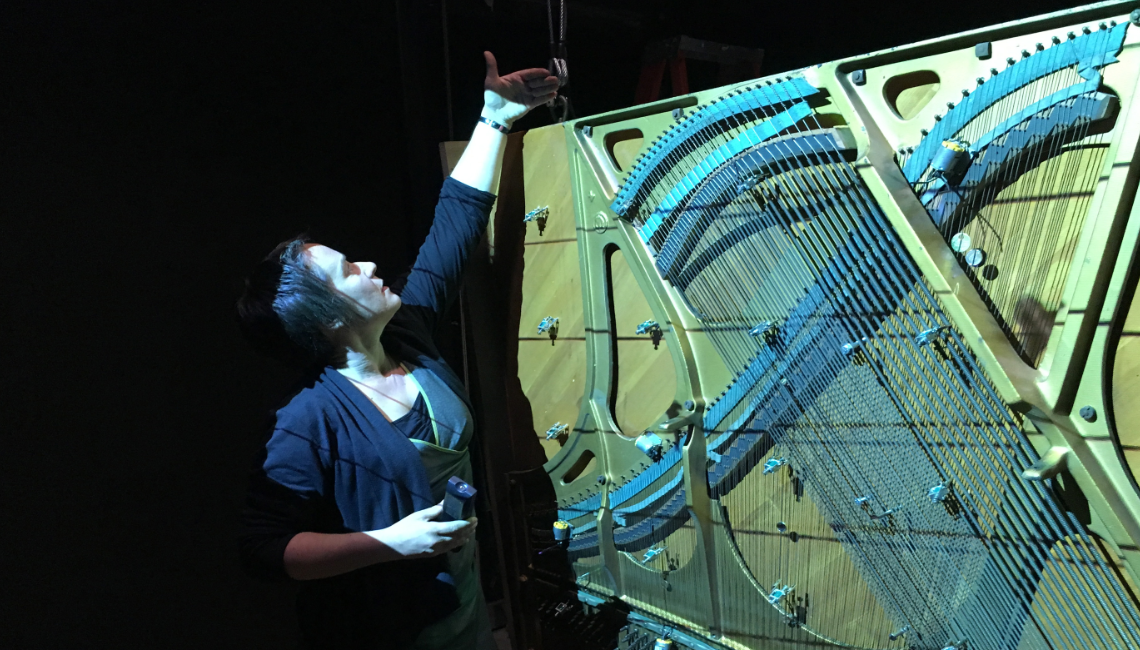
Biography
Kathy Hinde’s work grows from a partnership between nature and technology expressed through audio-visual installations and performances that combine sound, sculpture, image and light. Drawing on inspiration from behaviours and phenomena found in the natural world, she creates work that is generative; that evolves; that can be different each time it is experienced.
Kathy frequently works in collaboration with other practitioners and scientists and often actively involves the audience in the creative process. She has created light and sound installations in public spaces, including town high streets and nature reserves.
She has shown work across Europe, Scandinavia, China, Pakistan, USA, Colombia, Brazil and New Zealand. She is a Cryptic associate, since 2015. Kathy received an Honorary Mention at Prix Ars Electronica 2015 for Tipping Point and Piano Migrations was runner up for the Sonic Arts Award 2014 and listed for the Aesthetica Art Prize 2014. Kathy received an Oram Award in 2017.
Kathy frequently works in collaboration with other practitioners and scientists and often actively involves the audience in the creative process. She has created light and sound installations in public spaces, including town high streets and nature reserves.
She has shown work across Europe, Scandinavia, China, Pakistan, USA, Colombia, Brazil and New Zealand. She is a Cryptic associate, since 2015. Kathy received an Honorary Mention at Prix Ars Electronica 2015 for Tipping Point and Piano Migrations was runner up for the Sonic Arts Award 2014 and listed for the Aesthetica Art Prize 2014. Kathy received an Oram Award in 2017.
Credits
Piano Migrations (2010)
2m x 2.3m metal frame with a suspended Piano Soundboard.
A sculptural, electronic media work comprising a locally sourced piano soundboard, video, sound, solenoids, computers and motors.
: Cryptic Glasgow Cryptic is a Glasgow based internationally-renowned producing art house
2m x 2.3m metal frame with a suspended Piano Soundboard.
A sculptural, electronic media work comprising a locally sourced piano soundboard, video, sound, solenoids, computers and motors.
: Cryptic Glasgow Cryptic is a Glasgow based internationally-renowned producing art house
Quayola (It)
Natures
Natures by Davide Quayola are a series of plant studies, described as vibrant, immaterial and contingent. The behavior of plants and flowers is interpolated through precise measurements and generative sound into a new synthetic order. The works in this series are based on the ‘clinamen’, an ancient idea that describes an unpredictable swerve or flow of atoms that was once understood as the origins of life.
Image
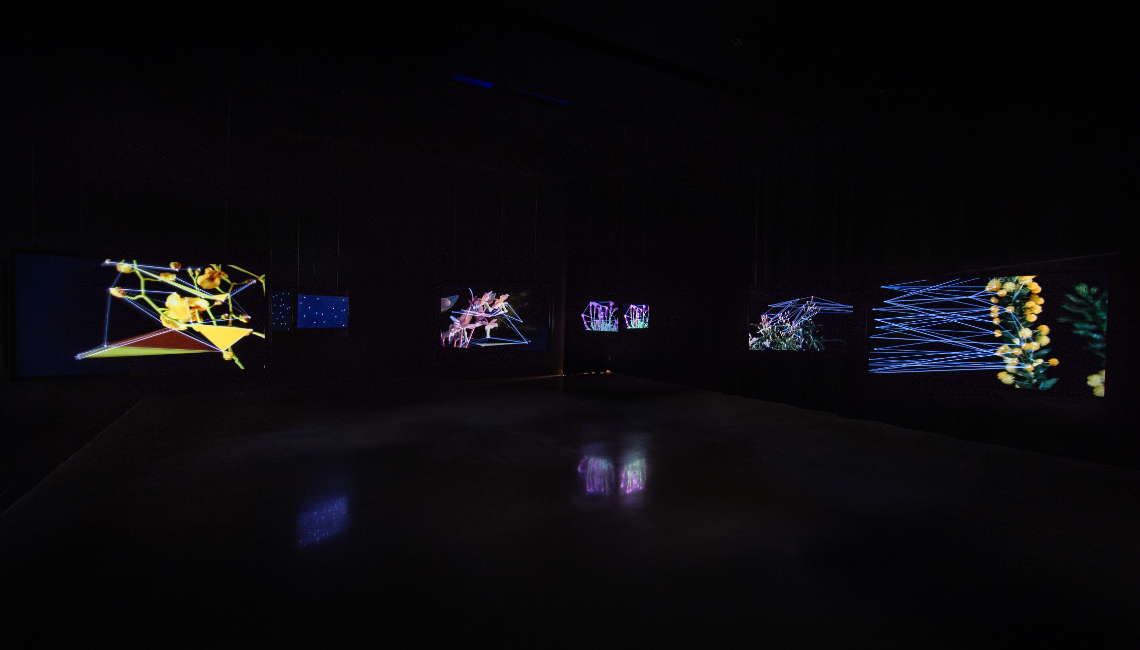
Biography
David Quayola b. 1982, Rome, Italy Lives and works in London, England.
In 2013, Quayola was awarded the Golden Nica at Ars Electronica. He holds a BA in Digital Media from the University of Arts, London.
Quayola employs technology as a lens to explore the tensions and equilibriums between seemingly opposing forces. His varied practice, all deriving from custom computer software, also includes audiovisual performance, video, sculpture, and works on paper. His work has been presented worldwide:
Pas Cultural Institute, London, England; London; Paco Das Artes, São Paulo, Brazil; National Art Center, Tokyo, Japan; Pushkin Museum, Moscow, Russia; Park Avenue Armory, New York, NY; Center for Fine Arts, Brussels, Belgium; Museu Nacional d'Art de Catalunya, Barcelona, Spain; Victoria & Albert Museum, London, England; MU Artspace, Eindoven, The Netherlands; British Film Institute, London, England; Gaîté Lyrique, Paris, France; Palais des Beaux Arts, Lille, France; Grand Theatre, Bordeaux, France; Saint-Eustache, Paris, France; Forum des Image, Paris, France; Phillips, London, England; Centro Cultural Recoleta, Buenos Aires, Argentina; EMPAC Centre, New York, NY; Yota Space, Saint Petersburg, Russia; Georgia Museum of Art, Athens, GA; MIS, São Paulo, Brazil; Casa Franca, Rio de Janeiro, Brazil; and BAC Center d’Art Contemporain, Geneva, Switzerland; among many other international festivals. Collaborations include Mira Calix, Plaid, Vanessa Wagner, the London Contemporary Orchestra, and the National Orchestra of Bordeaux.
In 2013, Quayola was awarded the Golden Nica at Ars Electronica. He holds a BA in Digital Media from the University of Arts, London.
Quayola employs technology as a lens to explore the tensions and equilibriums between seemingly opposing forces. His varied practice, all deriving from custom computer software, also includes audiovisual performance, video, sculpture, and works on paper. His work has been presented worldwide:
Pas Cultural Institute, London, England; London; Paco Das Artes, São Paulo, Brazil; National Art Center, Tokyo, Japan; Pushkin Museum, Moscow, Russia; Park Avenue Armory, New York, NY; Center for Fine Arts, Brussels, Belgium; Museu Nacional d'Art de Catalunya, Barcelona, Spain; Victoria & Albert Museum, London, England; MU Artspace, Eindoven, The Netherlands; British Film Institute, London, England; Gaîté Lyrique, Paris, France; Palais des Beaux Arts, Lille, France; Grand Theatre, Bordeaux, France; Saint-Eustache, Paris, France; Forum des Image, Paris, France; Phillips, London, England; Centro Cultural Recoleta, Buenos Aires, Argentina; EMPAC Centre, New York, NY; Yota Space, Saint Petersburg, Russia; Georgia Museum of Art, Athens, GA; MIS, São Paulo, Brazil; Casa Franca, Rio de Janeiro, Brazil; and BAC Center d’Art Contemporain, Geneva, Switzerland; among many other international festivals. Collaborations include Mira Calix, Plaid, Vanessa Wagner, the London Contemporary Orchestra, and the National Orchestra of Bordeaux.
Credits
Natures (2009 - 2010)
NMG installation : 6 channel video work presented on 18 varying sized monitors, suspended from ceiling.
Single sound track overlaid.
NMG installation : 6 channel video work presented on 18 varying sized monitors, suspended from ceiling.
Single sound track overlaid.
